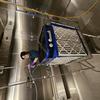Through extensive publications and active participation in consensus organizations such as the American Society of Heating, Refrigerating, and Air-Conditioning Engineers, the American Society of Mechanical Engineers, the American Society for Testing and Materials, and the Fully Integrated and Automated Technology Consortium, research results from the Division are disseminated to the private sector in a timely manner and provide the basis for many consensus standards used throughout the building industry.
News and Updates
Software
Awards
Contacts
-
(301) 975-5868


























